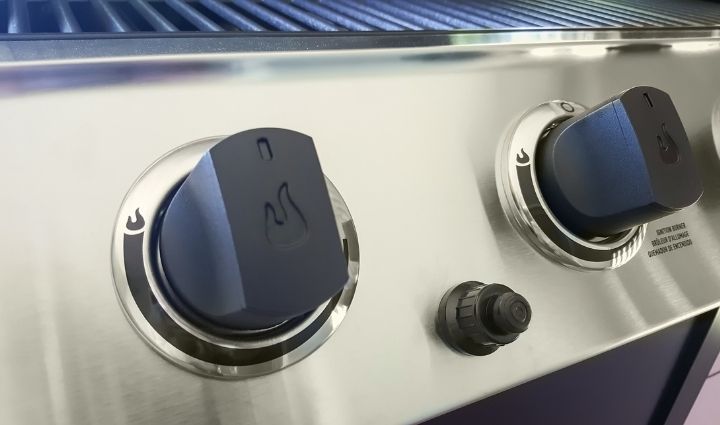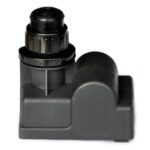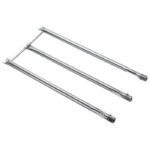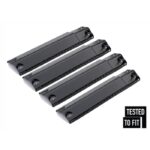Your gas grill’s igniter is an often-overlooked but extremely important component of your barbecue. Without an igniter, lighting your grill can be frustrating and inconvenient at best, and downright impossible at worst.
Making sure your igniter is clean and well-maintained is the key to ensuring your grill will start whenever you want to fire it up. Keep reading to learn about what a barbecue igniter does, how it works, when it should be replaced, and how to replace a grill igniter.
What is a Grill Igniter and How Do Grill Igniters Work?
A grill igniter is the ignition system on a gas barbecue. The igniter is what creates a spark and lights the gas supplied by the propane tank or natural gas line in order to create the flame you’ll use to grill. Once lit, the flame can be adjusted lower or higher using your grill’s control knobs.
Gas grill igniters consist of four main components:
- A spark generator generates the electric charge. There are two common types of spark generators: piezo igniters and battery-powered igniters. Piezo starters use no outside power source. Instead, they generate a charge by using a tiny spring-loaded hammer to hit a crystal such as quartz which emits the charge. Piezo starters will sound like a hard snap when pressed or turned. Battery-powered igniters use the voltage from a battery to generate a spark. Battery starters will click repeatedly when pressed.
- Igniter wires to carry a charge from the spark generator to the electrode.
- Electrodes that are attached to the ignition wire emit the spark that ignites the gas.
- A collector box to help capture the gas for quicker ignition.
To figure out what kind of spark generator you have, look for a battery pack. If there’s a battery pack, you have a battery-powered spark generator. If there’s no battery pack, you have a piezo igniter.
Some grills will have one igniter and carryover tubes that will carry gas and flame to additional burners, while other grills will have a dedicated electrode for each burner.
Why Isn’t My Igniter Working?
If you hear a constant clicking noise or a hard snap when you press your igniter button or turn the igniter knob but there is no flame, good news—your igniter is working! In this case, the issue may be with your burners or gas flow. To test your burners, read our article on troubleshooting and fixing gas grill burners.
If you hear no clicking or snap but the barbecue lights with a match or a lighter, the burners and gas flow are functioning properly and you may have an igniter issue. If your grill igniter isn’t working, don’t panic—most of the time, getting your igniter to function again is a quick and simple fix (or an easy replacement). Here are 4 common sources of malfunctioning igniters and how to fix them:
1. The battery is dead or corroded
Dead batteries are one of the most common causes of igniter issues. If you have a battery-powered spark generator, the first thing to try is replacing the battery. Concerns about battery life are not applicable to piezo igniters.
Replace the battery by turning the igniter button cover counterclockwise to remove it. Take out the old battery, insert a fresh one, and try lighting your grill. If the battery is corroded or the igniter still won’t spark after you replace it, the igniter may simply be dirty or need reconnecting.
GRILL SPOT TIP: If you tuck your grill away for the winter, remove the igniter batteries first. This reduces the risk of corrosion, and will also extend the lifetime of your battery.
2. The electrodes are dirty or corroded
Igniters are frequently subjected to dirt and debris from cooking fumes, grease, and food particles. If the electrodes are covered in gunk from months of grilling, your igniter won’t be able to spark.
Dirty electrodes are easy to fix—all you need to do is clean them using a cotton swab and a bit of rubbing alcohol. Gently rub the swab over the metal tip of the electrode, let it dry, and attempt to start the grill. It may take a few tries to get the electrode totally clean.
Electrodes can also become corroded from exposure to moisture, which can prevent a spark from generating. If your electrodes are corroded, you can lightly sand off the corrosion.
3. The electrodes or wire connections are loose
The placement of the electrodes and wire connections is crucial for sparking the burner.
Electrodes consist of a ceramic tube with a metal tip. The metal tip is what creates the spark and ignites the burner. The electrodes can be located in the collector box near the burner, which may be mounted in the front or side of the burner box, or on the side of the burner itself.
Start by ensuring that the gas is off, then inspect the components:
- Confirm the electrodes are in good shape and that the metal tips are still intact with no cracks or breaks.
- Check for frayed wires—wires can fray over time thanks to moisture and other inclement weather, and sometimes rodents will chew them up.
If everything is in good shape, disconnect and reconnect the electrodes from the wires to ensure there are no loose connections. Similarly, disconnect and reconnect the wires from the igniter box and ignition switch (if you have a remote switch unit) to ensure the connections are secure.
GRILL SPOT TIP: This is a great time to also check that the burner tubes are clear of debris and pests. Here’s how to clean your venturi tubes. Shop for flexible burner cleaning brushes.
4. Wet weather
If it’s raining or snowing, the igniter may simply be wet and unable to spark. In this case, gas will still be flowing and you should be able to carefully light your grill with a match or a gas barbecue lighter. The heat from the lit grill will eventually dry out the igniter.
When To Replace Igniter Parts
It’s time to replace your igniter parts if:
- You’ve replaced the batteries in the spark generator and it still doesn’t work
- You’ve cleaned the electrode(s) and it still doesn’t generate a spark
- If any of the wires or electrodes are corroded, frayed, or oxidized
How To Replace a Gas Grill Igniter
Both battery-powered and piezo igniters are easy to replace and it only takes a few minutes.
There are two basic types of electronic battery-powered gas grill igniters: ones that have a remote switch and an all-in-one type that does not have a remote switch.
- In remote switch units, the ignition button and spark generating unit are separate. The ignition button is mounted on the control panel, and two ignition wires attached to the button lead to the battery unit, which is typically mounted on the side panel of the grill storage cabinet.
- All-in-one ignition modules are self-contained and include both the battery unit and the ignition button. All-in-one ignition modules are mounted directly behind the control panel.
Follow these steps to replace a spark generator:
- Shut off the gas supply and make sure your control knobs are set to off and that the grill is cool.
- Locate the igniter box. Unscrew the visible front part of the igniter button, knob, or screws to loosen the collector box.
- Make note of how the wires enter the collector box, then disconnect the wires and remove the old collector box.
- Attach the wires of the new ignition kit to the appropriate ports. If your grill has an igniter for each burner, you may need to remove each control knob cover and the control panel to expose each spark generator. All you need is a screwdriver to remove the control panel.
- Screw the collector box back in place and fire up your grill.
Reignite Your Grill
BBQ igniters come in many configurations. It’s best to use an exact match of your grill’s current igniter if possible, but universal ignition kits are also available.
Cleaning your grill regularly is the best way to extend the lifetime of your igniter—and just about any grill part. Follow our instructions for cleaning your gas grill to keep your barbecue in top-notch condition year-round.





